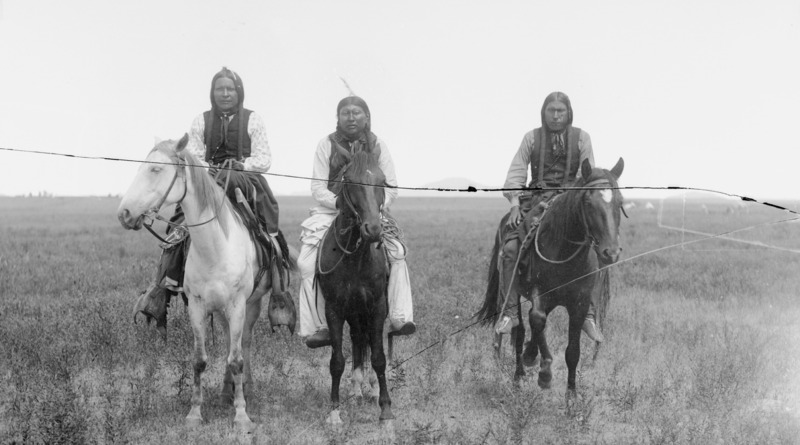Santa Fe Trail’s Indigenous Origins

Hutchins, 1892. [Three young braves on horseback], Glass Negatives of Indians (Collected by the Bureau of American Ethnology) (1850s–1930s). Photographs. Courtesy of the National Anthropological Archives, Smithsonian Institution. Via Artstor. https://library.artstor.org/asset/NMNH_125724741.
The Santa Fe Trail was a conduit of trade in the Americas controlled by the Comanches and Utes.
The Santa Fe Trail is one of the symbols of American westward expansion and Manifest Destiny. The trail runs from Independence, Missouri to Santa Fe, New Mexico and was a major artery of trade between American pioneers, Mexican settlers, and most significantly, indigenous peoples. For decades before and throughout its history, the trade along the Trail was controlled by its main beneficiary: the Comanche nation.
The first man to make the journey from Santa Fe to Independence in the late 1700s was Pedro Vial, a Frenchman who had lived among the Comanche and was on peaceful terms with the powerful nation. Most Comanche–American relations around the advent of the 19th century were friendly and trade-based because of the Comanche’s ambitions for economic expansion. To the delight of the Comanche, declining Spanish colonial power in the American Southwest culminated in Mexican independence in 1821, sweeping away barriers to trade/
Through utilizing Spanish horses and raiding tactics, the Comanche had already established themselves as the dominant force in the Southwest. This was evident through the significant contractions of the neighboring tribes and the Spanish colonists themselves. An American officer, General Stephen Long, was the subject of a second-hand account of Comanche-Spanish conflict in the nineteenth century: “It was stated last fall by the Spanish officers at the Sabine, who were attached to the Spanish expedition against Gen. Long and his followers, that those Indians had, within the last season, destroyed upwards of 1000 families on the Rio del Norte, and in parts of the Spanish provinces.” The Americans recognized that the Comanche were a force to be respected.
While the Comanche could be brutal to those who didn’t cooperate with their terms, the Santa Fe trade flourished under their control. Tens of thousands of dollars of goods moved along the trail between 1820 and 1840. American traders like Josiah Greggs and Thomas James learned to pay for their passage and abide by Comanche rules and traditions, and they profited for years off of their economically beneficial friendship. James himself was even adopted into a Comanche tribe as a result.
Unfortunately for many American and Mexican settlers along the trail—therefore in Comanche territory—this meant Comanche tributary demands. When these demands for tribute or trade were not met, settlers suffered the consequences. Entire settlements in present-day Texas and New Mexico were destroyed because of their lack of cooperation with Comanche trade policy.
Images

Hutchins, 1892. [Three young braves on horseback], Glass Negatives of Indians (Collected by the Bureau of American Ethnology) (1850s–1930s). Photographs. Courtesy of the National Anthropological Archives, Smithsonian Institution. Via Artstor. https://library.artstor.org/asset/NMNH_125724741.

